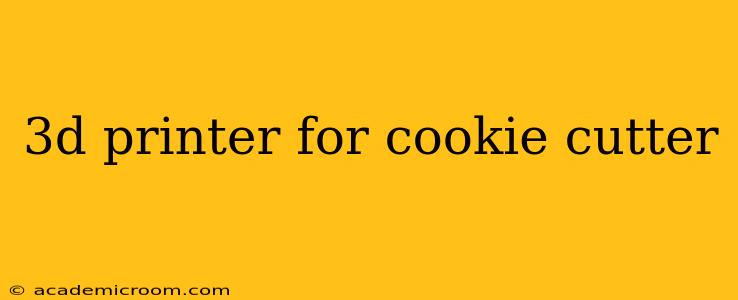3D Printing Your Own Custom Cookie Cutters: A Sweet Idea
Want to bake cookies with uniquely shaped cutters? Forget the limitations of store-bought options and unleash your creativity by 3D printing your own custom cookie cutters! This guide explores the exciting world of 3D printing and its application in creating personalized, intricate, and fun cookie cutters. We'll cover everything from choosing the right 3D printer to designing your cutter and ensuring it's food-safe.
What kind of 3D printer is best for making cookie cutters?
The best 3D printer for making cookie cutters is one that offers precision and uses a food-safe material. While many printers are available, focusing on a few key features is crucial. Look for a printer with a relatively small nozzle size (0.4mm or smaller) for detailed designs. The type of 3D printing technology isn't as critical; both Fused Deposition Modeling (FDM) and Stereolithography (SLA) printers can create cookie cutters. However, FDM printers are generally more affordable and easier to use for beginners. Remember to always check if the filament you choose is explicitly rated for food contact – this is paramount for safety.
What material is best for 3D printing cookie cutters?
Food safety is the top priority when choosing a material for 3D printed cookie cutters. PLA (polylactic acid) filament is a popular choice for FDM printers because it's biodegradable and generally considered safe for indirect food contact. This means the cutter shouldn't come into direct contact with wet ingredients or be submerged in water. Always thoroughly wash your 3D-printed cutter with soap and water before and after use. Never use a material that is not specifically labeled as food-safe. Always research the specific filament's certifications and safety guidelines before use.
How do I design a cookie cutter for 3D printing?
Designing your cookie cutter can be as simple or complex as you like! Several free and paid software options are available for 3D modeling. Tinkercad is a user-friendly option for beginners, while more advanced software like Blender allows for intricate designs. Remember to design your cutter with a slight thickness (around 3-5mm) to ensure durability and prevent warping during printing. Consider adding small holes or cutouts for easier handling and to prevent the dough from sticking.
How thick should my 3D printed cookie cutter be?
The ideal thickness for a 3D-printed cookie cutter is usually between 3mm and 5mm. This thickness offers a good balance between durability and ease of use. Thicker cutters are more robust but can be harder to handle. Thinner cutters might be easier to use but may be more prone to bending or breaking over time.
Is PLA filament food safe for cookie cutters?
PLA filament is generally considered safe for indirect food contact. This means the cutter should not come into direct contact with wet ingredients or be submerged in liquid. Always thoroughly wash your cutter with soap and water before and after use. However, it's crucial to verify that the specific PLA filament you're using has been certified for food-safe applications. Look for clear labeling and documentation from the manufacturer before using it for cookie cutters. It's better to err on the side of caution; if unsure, avoid using it for food contact.
What software can I use to design a cookie cutter for 3D printing?
Several software options cater to different skill levels:
- Tinkercad: This is a free, browser-based software ideal for beginners. Its intuitive interface makes it easy to create simple shapes and designs.
- Fusion 360: A more advanced, professional-grade CAD software (subscription-based), offering greater control and complexity for experienced users.
- Blender: A powerful, open-source 3D creation suite suitable for advanced users comfortable with 3D modeling concepts.
By following these guidelines, you can safely and creatively design and 3D print your own unique cookie cutters, transforming your baking experience. Remember that safety should always be your priority when working with food and 3D-printed materials. Happy baking!
